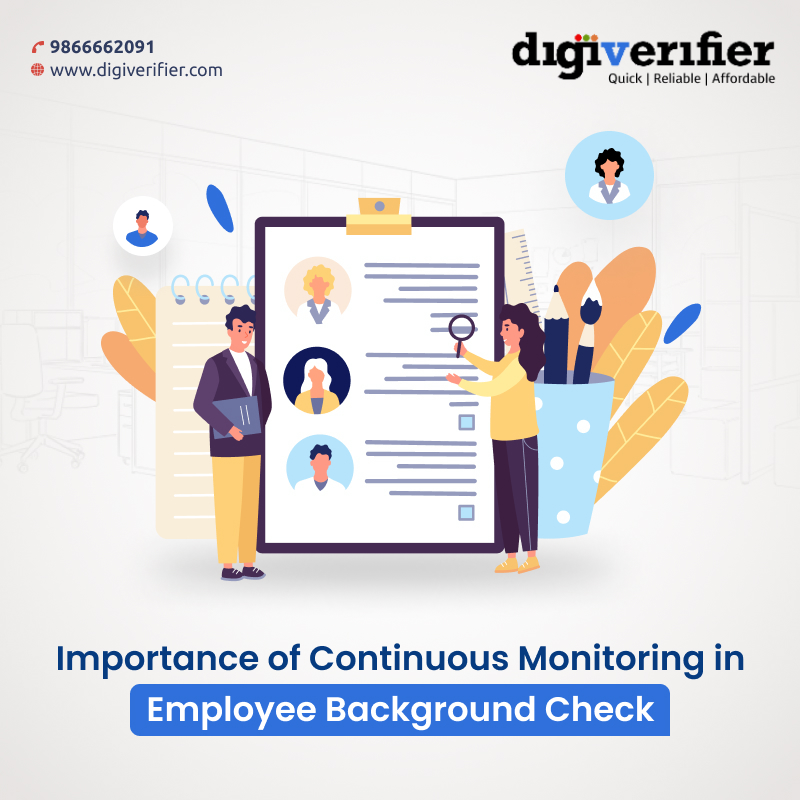The Significance of Continuous Monitoring in Employee Background Checks
 January 18th, 2024
January 18th, 2024
In the ever-changing business landscape of today, it is critical to guarantee the dependability and honesty of an employee. Even though they are necessary, traditional one-time background checks might not give a complete picture of an employee’s past and present behaviour. This is where it becomes clear how important it is to monitor ongoing employee background checks. This blog post by BGV Vendor will discuss how background checks are changing and how important it is to have ongoing monitoring to keep your workplace safe and reliable.

The Evolution of Background Checks
Background checks on potential hires have long been a standard procedure. Typically, these investigations entail confirming a candidate’s criminal history, work history, and educational background. But in the quickly evolving workplace of today, the conventional method of running background checks solely at the time of hiring has proven to be insufficient.
Businesses are recognizing more and more that ongoing observation is necessary to deal with the changing character of employee behaviour and associated hazards. Background checks have to change from being one-time events to continuous processes due to the advancement of technology and the globalisation of society.
Constant Observation
-
Adapting to Change
Employee circumstances are subject to constant change in the business landscape. Organisations can instantly adjust to these changes thanks to ongoing monitoring. Regular checks assist businesses in staying informed and reducing risks in a timely manner, regardless of changes in financial stability or legal issues.
-
BGV Vendor Integration
The success of continuous monitoring depends on selecting the appropriate BGV vendor. Organisations can expedite the process and get timely updates on any pertinent changes in an employee’s background by integrating a reputable BGV vendor.
-
Moonlighting Dangers
Working two jobs in addition to one’s primary job, or moonlighting, can be extremely risky for an organisation. Moonlighting employees run the risk of jeopardising the commitments made to their primary job, which could result in conflicts of interest or legal problems. One effective strategy for quickly identifying and stopping moonlighting is continuous monitoring.
-
Legal Compliance
Standards for compliance and regulatory requirements are always changing. Organisations can guarantee continued adherence to industry regulations with the support of ongoing monitoring. Companies can proactively handle compliance issues and prevent legal complications by keeping up with any legal issues or changes in an employee’s background.
The Benefits of Continuous Monitoring
-
Risk Mitigation
The first benefit of continuous monitoring is risk mitigation, which is achieved by the proactive identification and reduction of risks prior to their escalation. Organisations can safeguard their reputation and lessen the impact of any unfavourable incidents by routinely reviewing the backgrounds of their employees.
-
Employee Trust and Security
An environment of trust and security at work is fostered by a commitment to ongoing monitoring. The efforts made to maintain a safe workplace are valued by workers, and open communication between employers and employees can strengthen that bond.
-
Real-time Alerts
In the event that an employee’s background information changes noticeably, continuous monitoring sends out real-time alerts. Whether it’s a fresh legal case, a money problem, or engagement in unapproved outside activities, prompt notifications enable employers to respond promptly and intelligently.
Implementing Continuous Monitoring Effectively
-
Clear Communication
Effective continuous monitoring implementation depends on clear communication. The company’s commitment to continuing background checks and the rationale behind it should be communicated to the workforce. Openness fosters confidence and lessens opposition to programs aimed at ongoing surveillance.
-
Legal Considerations
When implementing continuous monitoring, organisations must adhere to both domestic and international privacy laws. It’s critical to strike the correct balance between protecting employee privacy and security monitoring.
-
Regular Training
Make certain that pertinent stakeholders and HR professionals are regularly trained on the newest trends and best practices in continuous monitoring. This information guarantees that the monitoring procedure continues to be efficient, legal, and in line with industry norms.
-
Cost Savings
Constant monitoring can lead to long-term cost savings, but traditional background checks have upfront costs. Risks can be quickly identified and addressed to avoid expensive legal disputes, reputational harm, and other financial consequences.
Conclusion
For companies looking to build a safe and dependable workforce, ongoing monitoring of employee background checks is more than just a trendy practice. Organisations can maintain a culture of trust, stay ahead of possible risks, and adjust to the changing needs of the business world by embracing continuous monitoring.
Enhancing the efficacy of background checks requires selecting a trustworthy BGV Vendor and addressing the risks associated with moonlighting through ongoing oversight. Businesses’ methods for employee screening should also change as they grow. The long-term success of any organisation is facilitated by proactive risk management and real-time insights provided by continuous monitoring, which becomes a potent tool.
